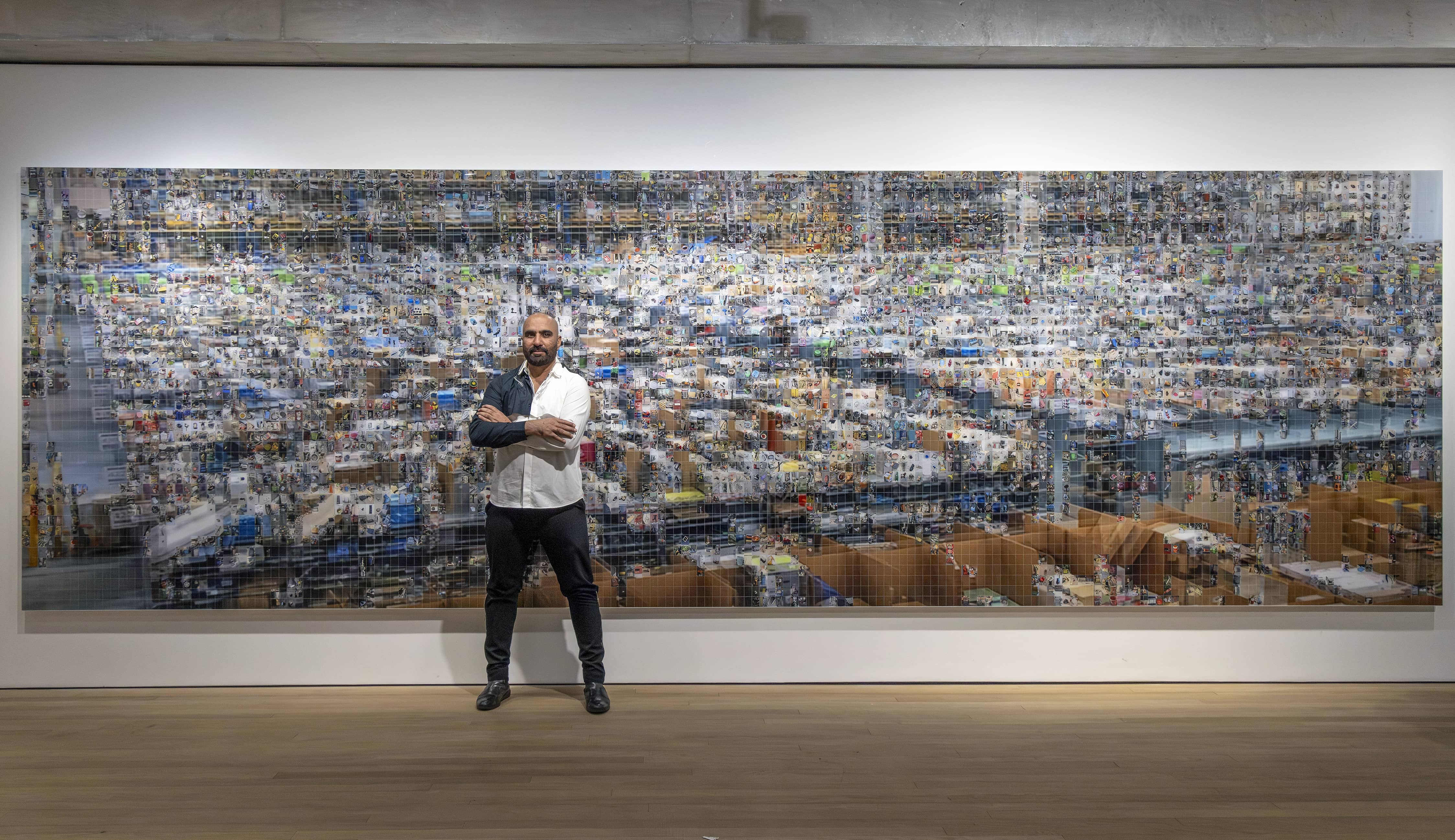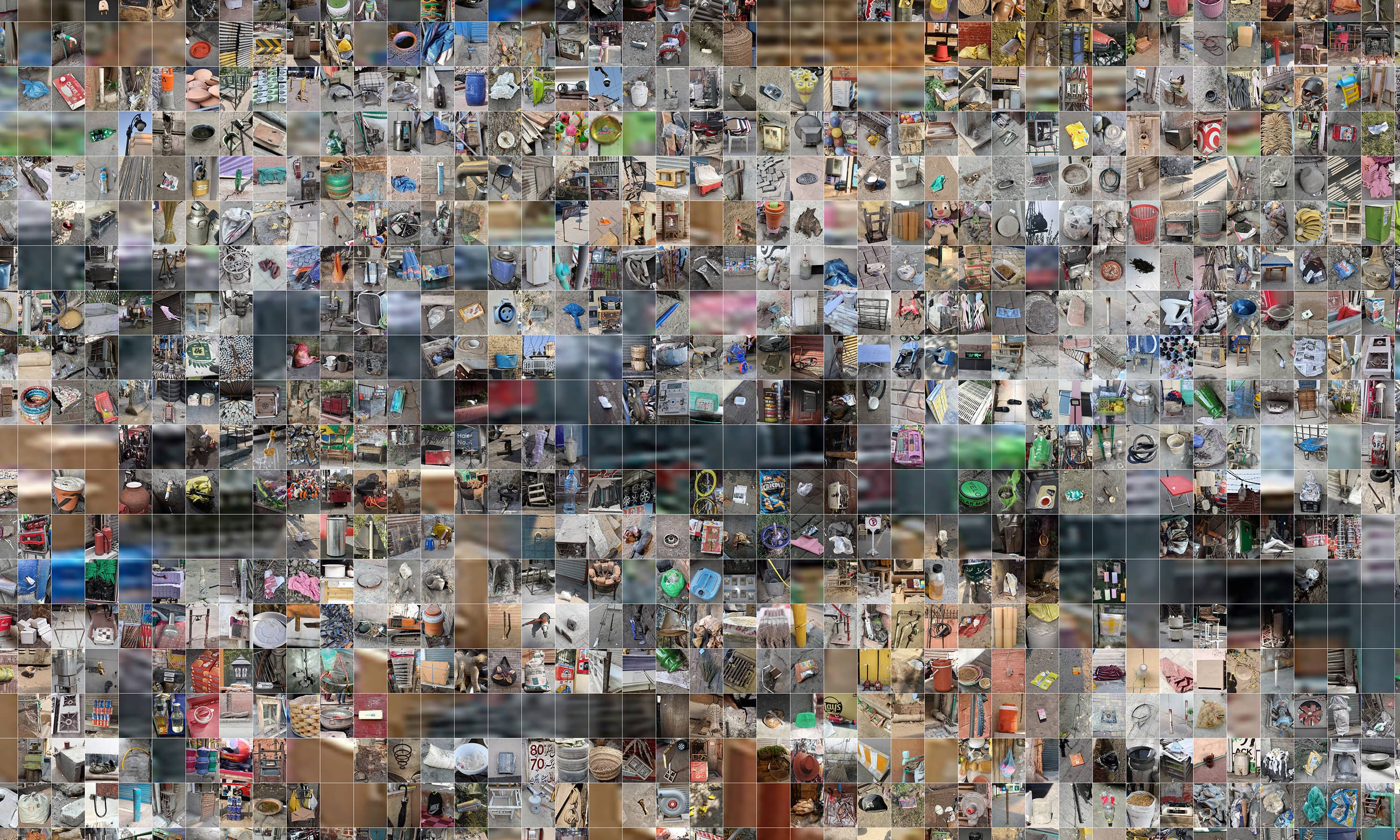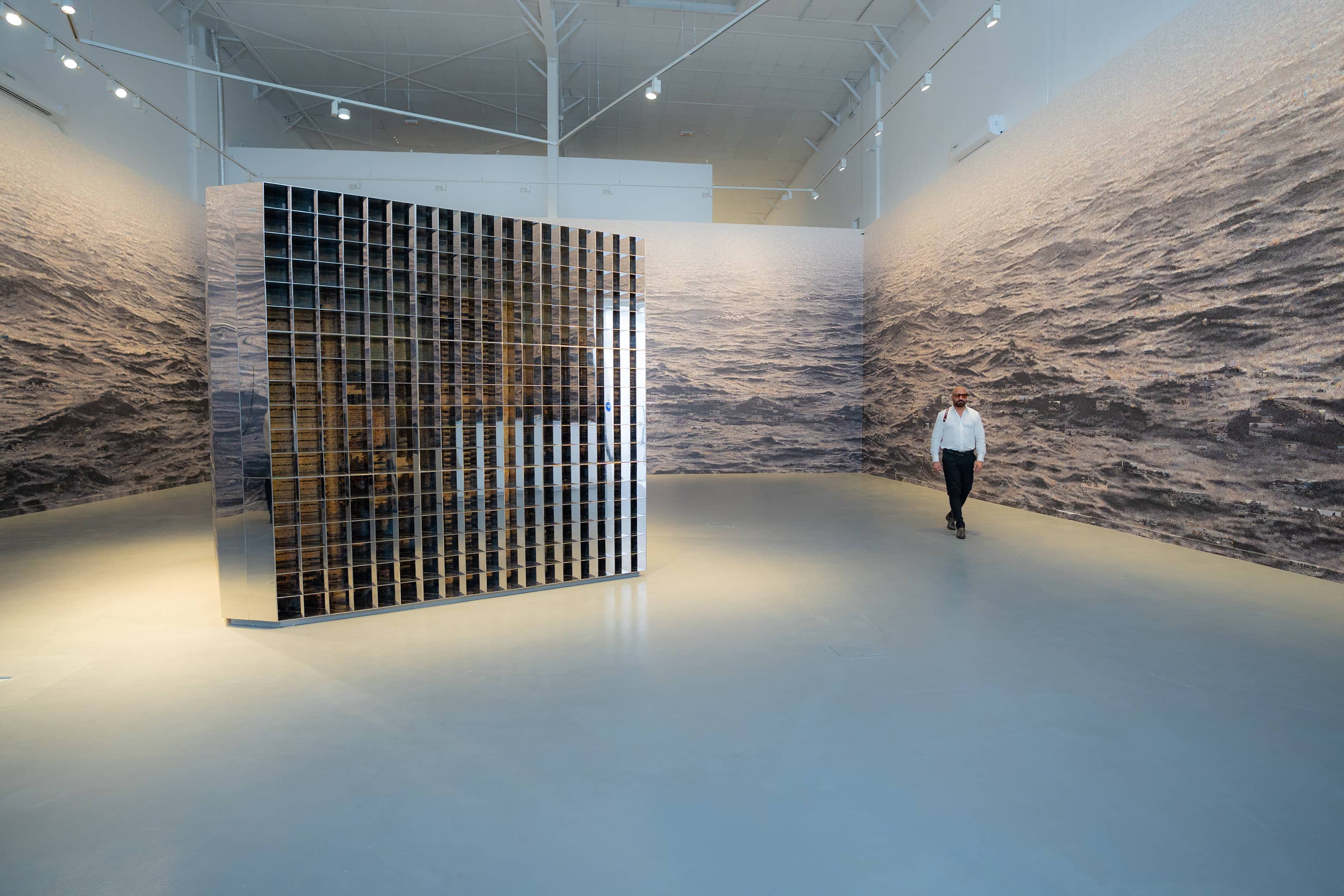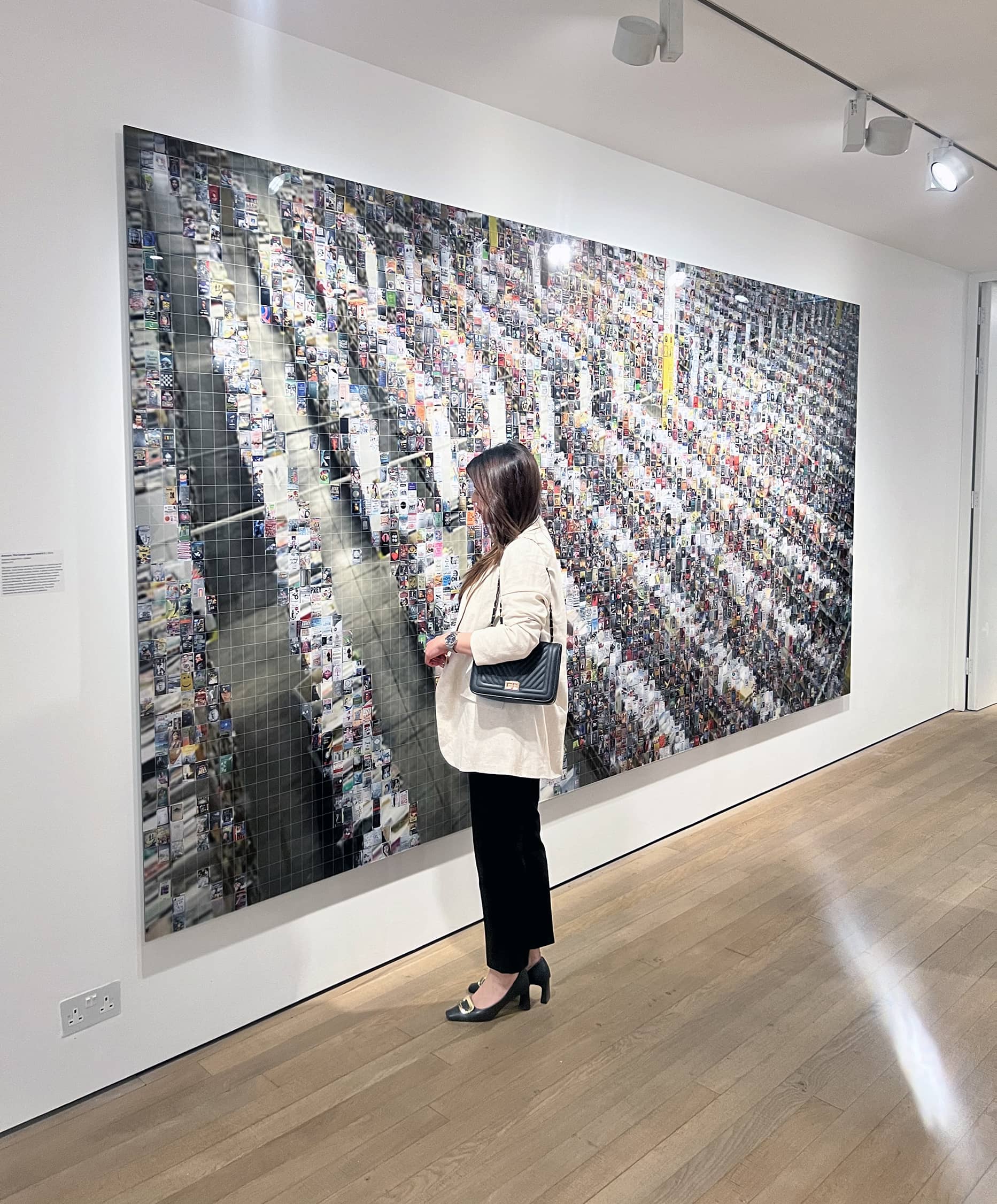Big topics, small details
Big topics, small details: Rashid Rana on the art of manifestation in macro and micro

Rashid Rana with his work_photo by Vipul Sangoi
Rashid Rana’s recent exhibition ‘Fractured Moment’ swiftly became a talking point when it opened in London recently, with audiences queuing up to view the gargantuan image of an Amazon depot which, on closer inspection, gave way to contrasting micro images of life in Lahore. In this interview, the South-Asian artist explains why he thinks the show resonated with viewers and voices his satisfaction that it helped to spotlight pressing topics that are, perhaps, at risk of issue fatigue.
Can you trace your artistic journey for us and explain how you began producing an entirely new kind of art?
Although I have been trained as a painter, I realised early on that it was important to avoid conforming to any specific ideas or perceptions of what an artist should be and remain open to new possibilities – in art making, curriculum making and exhibition making. I wanted to steer clear of any kind of categorisation and it felt important to let my practice evolve naturally.
I’d begun using digital imaging around the turn of the 21st century as part of my preparation process. Looking back, I think that Generation X - my cohort - was highly sensitive to the shift from analogue to digital because we experienced it first-hand in and outside of work. I decided that if these tools could serve my ideas then I should consider using them - and that’s what I’ve done. My work became more idea-driven and, in sync, I found myself experimenting with various new tools and formats more freely. These allowed me to move further into the 3D realm. I still regard myself as a conformist, exploring the concept of duality and how humanity has engaged with it - it’s just that my practice has evolved to encompass the use of pixel.
Unburdening from self-imposed pressure of dogmatic ideas of affiliating identity to political and cultural boundaries has been one of the core ideas in my practice throughout my career. Every image, idea and truth encompasses its opposite within itself. This internal conflict translates into my work at a formal level, as well as having geographical, historical and political connotations. In an idea-driven practice, I simply think of ideas and look for ways to manifest them.
Most recently, I coined the term EART. The manifesto of possibilities 01 initiates discourse parallel to art or outside of art. EART etymologically is the archaic term for art; a phenomenon we can identify the past and the present with. It is about real-life actions and activities, transactions, mediations and interventions of all kinds which, on account of the strength of expression, transcend their original function.

DETAIL, Amazon, The Center cannot Hold, 1, 2025, Archival Inkjet Print, DIASEC, 198 x 640 cm by Rashid Rana
Your work features groundbreaking combinations of formats. Do you think we have arrived at a point in time when artists cannot afford to ignore these elements in their work if they are to reach new audiences?
My philosophy is that the tools of an artist should always serve the ideas rather than vice versa. Tech is becoming a major part of our lives today, it works well with other media formats and I think diverse approach is something to be encouraged.
In my own practice, I have a sense of inevitability when it comes to making use of certain tools and exploring new technological advancements. Looking ahead, we need to think about how the physicality and materiality of mediums will manifest themselves.
‘Fractured Moment’, your recent exhibition at Frieze Rooms in London, was hailed a resounding success. Why do you think it received such a positive reception from audiences?
I was pleased with the positive feedback for ‘Fractured Moment’, in part because I’m highly self-critical of my work. It’s difficult to pinpoint specific reasons why viewers reacted favourably to the exhibition; perhaps the presentation of dual worlds in this body of work resonated with them. Many who saw the work were already familiar with the subject of the macro image - a vast Amazon depot - but the realisation that upon closer inspection, they were looking at small images of everyday objects framed as portraits located in Lahore seemed to strike a chord with the audiences.
I also wanted to touch on the notion that living in the Global South is not binary, but much more complex and non-linear. If you visit cities like Lahore, Delhi or Cairo, you will see 19th, 20th and 21st century running concurrently. I’m hopeful that my attempt to present a more panoramic view of the realities of life in a global context reached the audiences.

Rashid Rana with his work Desperately Seeking Paradise I and It Lies Beyond 2023
Topical issues are to the fore in your work. Do you think that your innovative way of treating these subjects can help to add weight to these topics, some of which are perhaps at risk of ‘issue fatigue’?
I made a conscious decision early on in my career to create work that would appeal to people who don’t necessarily attend art shows routinely, and engage with audiences who hold differing views. In this regard, the formal and conceptual device of micro and macro has worked distinctively well for my intended purposes; what appears simple at first sight gradually unfolds into deeper content.
Art can play a highly effective role in these scenarios because it has the ability to say the same thing in various ways. I am a firm believer of the form being the content - in other words, art’s power lies in how, rather than what is being said.
It's important to continue looking for fresh ways to manifest topics that are important but overly explored. The subject matter is not an end but a point of departure. For a creative practitioner, the form is important and the language is the real meaning of the work. One example is ‘Ten Differences’, the 53-second-long mirrored video I made in 2004, in which I appeared in two frames, pointing a gun at the other persona (myself). The idea was to use an active and engaging strategy to explore the concept of internal conflict and make a commentary on how violence has a tendency to turn inwards.

Rashid Rana, Amazon, The Center cannot Hold 3, 2025, Archival Inkjet Print DIASEC , 198 x 382 cm
Your work has been exhibited widely and you are also the recipient of key awards. What, from these or others, do you regard as your career highlights?
Being recognised is a great feeling, especially at home in Pakistan, and the awards I’ve received have all proved memorable in their own way. It is hard to select one over the other. Some achievements have felt extra special, such as the ‘Grid <> Matrix’ show held in 2006 at the Mildred Lane Kemper Art Museum in St. Louis, Missouri. The premise for the entire event was that the aesthetics of grid hadn’t died in the 20th century but instead, were continuing through pixelation and unsurprisingly, this really resonated with me. I had the opportunity to exhibit my work internationally alongside prestigious artists. Another would be when my work was included in an exhibition ‘The Treasures of The World’ curated from the collection of the British Museum. The exhibition was held at the Singapore Museum and was dubbed by media as “Human History in 239 objects”.
As a leading artist of your generation in South Asia creating a new kind of art, you are currently setting the bar high in your field. Does this ever faze you?
Admittedly, the pressure is always there - external and, for artists, the pressure we put on ourselves. But I certainly haven’t run out of ideas. We live in a world full of topical issues - both positive and negative - which offer plenty of subject matter for image production and dissemination. I’m always keen to avoid superficial stylistic conventions related to my South-Asian roots, and I don’t want to emulate the mainstream of the First World art scene either. This is my main challenge - reconciling the two experiences of actual (direct experiences) and remote (knowledge amassed indirectly) in art, rather than the dichotomy of East and West, to diffuse hard boundaries. The result is a meditation on location, both in a physical as well as temporal sense. The focus is on creating new legacies.